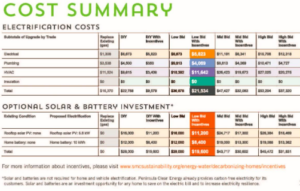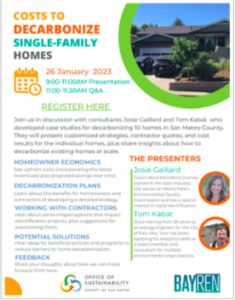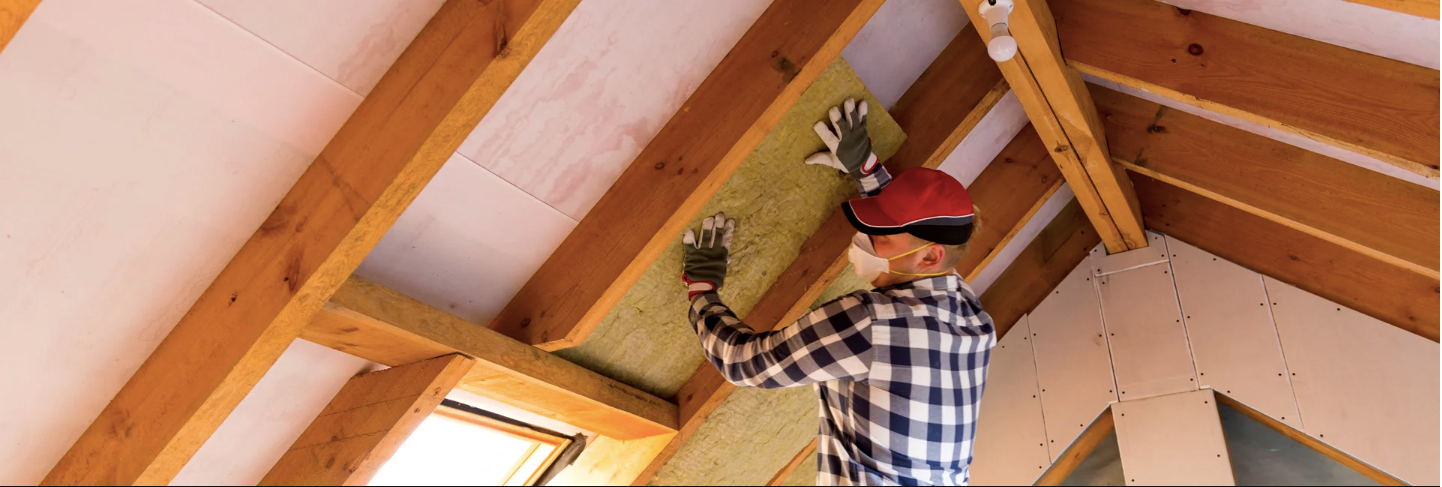June 2, 2023
Topic
Earlier this year, the County of San Mateo unveiled its groundbreaking study that explores the costs to decarbonize 10 different types of single-family homes on the climatically diverse peninsula. The results of this study added to collective knowledge and can help inform strategies for decarbonizing single-family homes at scale. This article uncovers how the study evolved, how it was conducted, and what’s next.
The County started by wanting to understand the overall industry landscape: the barriers to electrifying existing single-family homes and opportunities for collaboration to accelerate progress. So, in fall of 2020, the County received funding from the Bay Area Regional Energy Network (BayREN) to lead a system mapping project in collaboration with Presidio Graduate School, managed by Susan Wright. During a focus group with homeowners for the project, the County learned that homeowners were interested in receiving customized home electrification plans to help guide their electrification journey.
Separately, Kim Springer (now with the City/County Association of Governments of San Mateo County) recognized the importance of conducting a study to better understand the costs of electrifying homes. BayREN agreed to fund this study, as well.
After a competitive procurement process, in spring 2021 the County selected consultants Josie Gaillard and Tom Kabat to lead the study to answer the following questions: What does it cost to decarbonize 10 different types of homes in San Mateo County? What can we learn from helping homeowners understand how to decarbonize their homes?
The County selected 10 homes to study out of more than 70 nominated by their owners via an online survey. The final 10 homes vary by their location throughout the county, vintage, size, panel size, and household income. To determine the costs, the research included soliciting quotes for each of the decarbonization measures from three different contractors.
Tom and Josie conducted introductory calls with each homeowner, and then conducted a two-hour site visit at each home. Because the study was being conducted in the height of the pandemic, the decision was made to limit the amount of in-person interactions with the homeowner. This also gave the County the opportunity to test a new process to see how it might help accelerate quotes for the future. Instead of having each of the contractors go to each home, Josie and Tom developed contractor quote request packets for the contractors to respond to. The packets included drawings and detailed home electrification plans with equipment types, sizing, locations, and controls, heat loss calculations per Manual J, and panel load calculations per NEC 220.83 (B). (Figure 3)

Figure 1

Figure 2

Figure 3
Tom, Josie, and the project team recruited and screened 50+ contractors to provide quotes from five different trades. They selected 11 contractors to solicit bids from. They proceeded to review the bids, asked questions and requested changes. With all the bids in hand, Josie and Tom analyzed the data and ran financial projections (Figure 4). Then they met with each homeowner to present their home’s cost plan and available incentives which were based on the specific features of the home (Figure 5).

Figure 4

Figure 5
In January 2023, the County hosted a 2.5-hour webinar to present the study and lessons learned through the process to 100+ industry professionals. (Figure 6). A recording of the webinar, along with the 10 cost plans and contractor bid packets, are posted here: https://www.smcsustainability.org/energy-water/decarbonizing-homes/

Figure 6
In February 2023, the County hosted an informal follow-up conversation with 20 people who attended the webinar to discuss the following question: What steps should the County of San Mateo take now? Attendees suggested that the County publicize the findings even more widely, address the need for permit simplifying, start a turnkey home electrification program, train contractors, and fund implementation of similar home electrification projects. The County is still considering next steps.
Meanwhile, this summer, the County has been following up with the 10 homeowners that participated in this study to learn if they have implemented any of the recommendations made in their home electrification plan.
If you’re interested in producing a similar cost study or would like more information, contact Alero Moju at the County of San Mateo Office of Sustainability: amoju@smcgov.org





